Are procrastinators exaggerators?
More than half of students tend to put off work until the last moment. A dive into the mechanics and controllability of procrastination.
That procrastination is a problem is something everyone can imagine. For example, I started this article only in the last week, with most of the work done in the last two days. As a result, my co-editors have had less time to edit, translate and suggest improvements. In an ideal world, I would have finished this article last week, leaving buffer for that kind of collaboration or to let the end result marinate for a while and be able to look at it again later with a fresh perspective.
Despite the multitude of self-help books and productivity tips, procrastination, or the behavior of delaying tasks, remains a pervasive and peculiar problem. Peculiar, because of the way your brain tricks you into consciously walking in the opposite direction than you would have liked - before conveniently forgetting about it. In psychology, this behavior is also described by all kinds of motivation theories, with the following formula as an ultimate simplification of reality:

Here, motivation for a task is a function of a few relevant factors (Steel & Klingsieck 2016). Your motivation increases when the certainty of success and the value of the outcome is high, but decreases when this outcome is further in the future or you have impulsive traits. Procrastination happens when these factors come together, resulting in more motivation for a quick and easy activity rather than the planned work (Figure 1). Of course, the workings of your brain and resulting behavior are much more complicated. However, for practical purposes, I think it’s best to take a closer look at procrastination in a more relatable way.
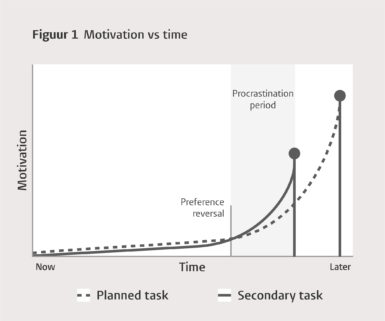
Source: Steel & Klingsieck, (2016)
Why it can be a problem
Many people say that they are only able to perform well under pressure. I always thought this too, but I only realized to what extent procrastination is a problem after reading an article by Tim Urban a few years ago, just when I decided not to start a master's degree after a period of pretty severe procrastination.
On his blog Waitbutwhy, Tim dives deep into topics that interest him and tells the story as completely as possible, supported by funny drawings and insightful diagrams. Due to his own experiences with procrastination while writing these deep dives, the tagline now reads "New post every sometimes" instead of "new post every Tuesday". In case you don't know this blog yet, I really recommend it.
In the post (or this TED talk), he explains behavior based on three figures in your head. Everyone has a rational side that wants to make a good decision, but sometimes you give in to activities that give you instant gratification. This ‘instant gratification monkey’ takes total control until your report deadline is a few hours away. Only then does the panic set in and you suddenly have no problem working for hours on end. Recognizable?
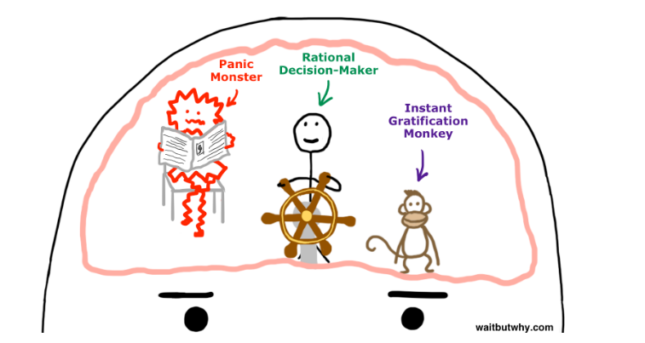
The problem with this is that up to the point that panic strikes, the rational side of yourself still takes over every now and then. For example, you might cancel an appointment to study, or take a whole day off to work on something. But then you fail to really get to work because other unimportant tasks (or simply useless distractions) take priority. Tim calls this the sinister playground. In this situation you're not really enjoying yourself, and you're not getting anything done. You're doing something "fun" like scouring Youtube, but feeling guilty at the same time. This ambiguity is very bad for you, both because it causes stress in the moment, and because you don't fulfil your dreams and avoid happy activities.
You may be familiar with the Eisenhower graph. This is a phenomenon in the productivity world named after former U.S. President Dwight Eisenhower. He classifies tasks based on urgency and importance:
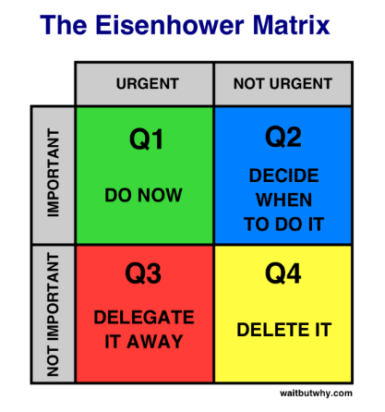
Tim has adapted this one to the life of a procrastinator:
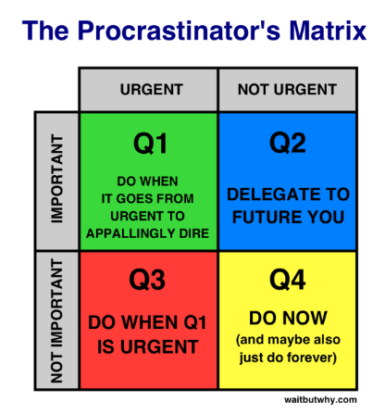
Doing something else for a while makes you feel better, but the long-term problem is not solved. Thus, his whole life revolves around the urgent or unimportant things, which generally goes well but as a result no time is spent in the Q2 quadrant:
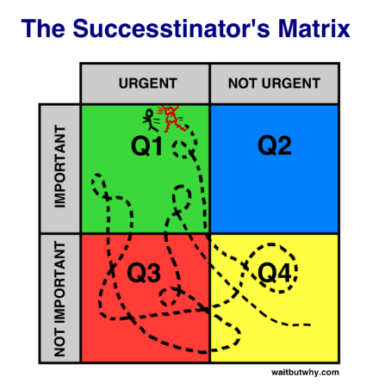
Whereas, in fact, the most interesting things happen when you set aside time for tasks that are important to you but don't necessarily have to happen. Consider, for example, learning to play an instrument, or taking a procrastination course. And Tim is even a successful procrastinator, but this can go on for days to weeks. There are plenty of people who barely get out of Q4, and can't get anything done. In the thousands of responses to his first article, he saw all kinds of people relate to his sentiments. A vast majority of which appeared to be PhDs.
Who is affected?
A report by the Amsterdam Student Union (ASVA) on stress factors among students found that 62% of students surveyed tend to often put off work until the last minute. Now, of course, procrastination is not only common among students. Other studies in several countries show that one in five people exhibit chronic procrastination behavior. But this percentage among students is bizarrely high. How is it that we didn't learn how to deal with this during high school?
It could be that there is much difference in the degree of procrastination these students exhibit or the extent to which they themselves consider it a problem. Rozental et al. (2022) found among their interviewees two groups with less severe and severe forms of procrastination, with almost all of the severe procrastinators seeing it as a problem compared to half of the less severe procrastinators.
Procrastination can also affect areas outside of studies or work. For example, according to Steel (2010), there are three different areas in which it can have an impact: Success (career, finances, education), self-development (health, self-development, spirituality), and intimacy (friends, family, parenting). You may be putting things off in one domain and, as a result, scoring well in the others.
Now you could say that this is a phenomenon of the modern age with all our distractions and changing work environments, but it rather seems to be a deeply ingrained human trait. It is already mentioned in texts from ancient times and a certain Anthony Walker devoted an entire book to it in 1692, called "The great evil of procrastination, or, The sinfulness and danger of defending repentance in several discourses." Perhaps as hunter-gatherers we simply had far fewer long-term goals? In our human behaviour, you will constantly find that short-term thinking is preferred over long-term thinking.

Personality trait or learned behavior?
In psychology, the "Big Five" personality test is often used. This classifies people on, you don’t say, five scales of a particular trait. Over the years, procrastination research has been able to distinguish different forms of procrastination, each based on a different imbalance in these traits.
These big five are extraversion, openness to experiences, conscientiousness, or agreeableness & neuroticism. Of these, the degree of conscientiousness and its underlying facets such as impulsivity or self-control is considered the most important predictor of procrastination in a personality profile (Steel & Klingsieck, 2016). Furthermore, it appeared that in 70% of the cases the behavior is explained by a high degree of extraversion and one's openness to new experiences (or wanting to avoid boredom).
Interestingly, getting balance in these traits is essential. Someone who scores high for neuroticism procrastinates because of a higher sense of anxiety, while someone who is not neurotic at all is deficient in stress or worry. Also, extroverts often procrastinate because of social stimuli while introverts do so because of a lack of energy or wanting to be alone for a while (Steel & Klingsieck, 2016).
Strategies to start tackling procrastination
Because of the complexity of the problem and the vicious cycle you get in when you are a heavy procrastinator trying to change your behavior yourself, it is not helpful to simply try to adopt all the methods used in articles or self-help books. In Tim's words, "The problem is that the articles are always written for sane people, and procrastinators aren't sane people. Being insane, procrastinators are always under the delusion that they're sane, so they read an advice article and think they'll be able to apply it to their life. But then it doesn't work out that way."
Since conscientiousness like impulsiveness and discipline seem to have the greatest connection to procrastination, it makes the most sense to focus solutions on these traits. But for each person, something different works best.

For example, my form of procrastination - if you’ll allow me to self-diagnose - seems to come from a lack of stress. This, according to Steel & Klingsieck (2016), can be aided by visualizing both the goal and the obstacles I put in front of myself. Doing this makes the goal and the advantages that come with completing it suddenly seem like something much more relevant to achieve than if I simply give in to one of those obstacles. This is called Mental contrasting. Sounds simple enough, now it’s time to try it out sometime 🙂.
Someone who procrastinates because of anxiety can try using the many anxiety-related methods that have gained much popularity in recent years because of the increase in related symptoms during the pandemic. And social pressure can also become a solution, as it not only provides distraction but can actually provide external motivation by telling someone you want to do a task by a certain time (and then being checked by that someone).
Finally, two tricks are always useful to remember. The first is the five-minute rule (also called two-minute rule, you get the gist): If a task takes less than five minutes, try to take a moment to realize that. This helps because you’ll realize that you can just be idle again afterward, and that makes the threshold much lower. A different version of this trick is useful when a task takes longer than five minutes. Work on it "for only" five minutes and you will suddenly wake up after having worked on it for an hour. Also, breaking the task down (mentally or on paper) into smaller and smaller pieces is a good way to get to those five minutes snippets, and is at the same time a good activity to become aware of the scale and difficulty of a task.
If you're dealing with this, you can attend the "Procrastination - Get Started!" workshop on the 10th of May, organized by the student psychologists of Leiden University. Click here for more information. Hopefully, this article helps you see your procrastination in a new light and actually do something about it. For me, writing it down certainly did.
Sources:
- Rozental A., Forsström D., Hussoon A. and Klingsieck K.B. (2022). Procrastination Among University Students: Differentiating Severe
Cases in Need of Support From Less Severe Cases. Frontiers in Psychology, 13:783570. https://doi.org/10.3389/fpsyg....- Steel, P. (2010). The procrastination equation: How to stop putting things off and start getting stuff done. Random House Canada.- Steel, P., & Klingsieck, K. B. (2016). Academic procrastination: Psychological antecedents revisited. Australian Psychologist, 51(1), 36-46. https://doi.org/10.1111/ap.121...- Afbeelding van figuur onder een klok: Midjourney prompt: 3D animation style photo. A sad clock-shaped person sitting on swings in a dark playground. It's a misty evening and the only light comes from a lamppost near the swings.- Afbeelding van boeken en trap naar de klok: DALL-E prompt: In the style of Magritte paintings, a long swirly staircase made of books going up in the air leading to a Mario golden star, with a background of clouds, and a clock-man standing beneath it.




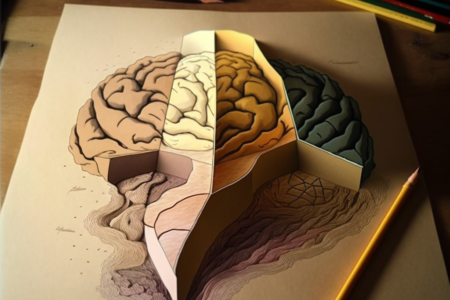

0 Comments
Add a comment